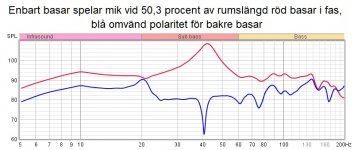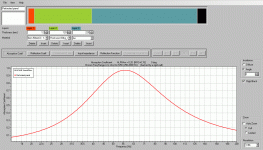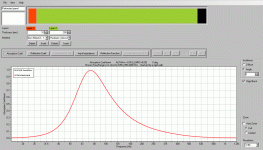Hi everyone.  Please need some help and advice...
Please need some help and advice...
I am trying to convert my cellar to a musicroom. Most for stereo and sometimes movies or with a cold one watching Lfc play football. Concret walls and celings/ floor. Low in height just 208 cm. Room is 580x364 so appr. 21 m2. Not the best start. A wall to wall thick carpet and a acoustic ceiling is planned. The good thing is that one wall is made of fibreboard and gypsum. And i have made place of some sort of a bass absorber. I have room for a 60x208 cm trap that is almost 45 cm deep in each corner. My first thought was a slat absorber but hard to come down to room modes frequencies. I love the look of a slat wall made of walnut or alike. My lowest axial mode is 29 Hz according to Amroc calc. Next is 48 Hz at sidewalls. Then 59 and 88 Hz and so on. I plan to have speakers at the wall with basstrap playing at longer dimensions of the room. It seems to be easier to get down to lower modes with a wall with round holes instead of slats. Or is it best just to fill it up with absorbing material? Or will it be
a overdamped room? Is it possible to fix the modes from 30Hz to say around 240 Hz. It will be a large bookcase or something for storing at back wall behind listening position. First reflexes will be treated with a thick absorbent on sidewalls and ceiling. Back of room walls will be more diffuse/reflecting than absorbing I think. Any suggestions from you about my room and planning?
/YNWA
 Please need some help and advice...
Please need some help and advice...
I am trying to convert my cellar to a musicroom. Most for stereo and sometimes movies or with a cold one watching Lfc play football. Concret walls and celings/ floor. Low in height just 208 cm. Room is 580x364 so appr. 21 m2. Not the best start. A wall to wall thick carpet and a acoustic ceiling is planned. The good thing is that one wall is made of fibreboard and gypsum. And i have made place of some sort of a bass absorber. I have room for a 60x208 cm trap that is almost 45 cm deep in each corner. My first thought was a slat absorber but hard to come down to room modes frequencies. I love the look of a slat wall made of walnut or alike. My lowest axial mode is 29 Hz according to Amroc calc. Next is 48 Hz at sidewalls. Then 59 and 88 Hz and so on. I plan to have speakers at the wall with basstrap playing at longer dimensions of the room. It seems to be easier to get down to lower modes with a wall with round holes instead of slats. Or is it best just to fill it up with absorbing material? Or will it be
a overdamped room? Is it possible to fix the modes from 30Hz to say around 240 Hz. It will be a large bookcase or something for storing at back wall behind listening position. First reflexes will be treated with a thick absorbent on sidewalls and ceiling. Back of room walls will be more diffuse/reflecting than absorbing I think. Any suggestions from you about my room and planning?
/YNWA
The bass traps of 60 x 208 x ca 45 cm in each corner will not do that much versus length modes. Even though the placement is good, you vill have about 240 cm width of the short walls which are not covered. So in your case, roughly 2/3 of the incoming wave has no or little treatment. If you wish to even out length and width modes, it would be more advantageous to use several subs at front and back walls. If your gypsum wall is a side wall, it may be that the subs should be placed somewhat assymetrical versus the room width to even out the width modes. Several subs costs more money of course, but will need less room space compared to efficient bass traps. Only 1 amp would be necessary if used as a mono-signal and subs connected in series / parallallell, depending on impedance.
Sub cabs don’t need to take up much floor space necessarily. As you are Swedish you can check up on I-or’s design for Ellujo at the forum faktiskt.io. In your case these subs would be placed vertical at the short walls instead of under a sofa. faktiskt.io • Visa trad - Sub-bas engagerar Foot print 12 x 60 cm x 150 cm, or your room height about 200 cm if you wish a larger cab. I-or is one extraordinary knowledgeable guy.
(I have a concrete basement myself, a bit lager than yours. Front superchunks with diagonal 86 x H 220 x D about 60 cm plus 2 rectangular BAD-panels 60 x 200 x 30 cm in the back corners, about 10% open area for the holes. Check out the picture with the red curve for the 2 nd room length mode at room centre. Quite a peak, in spite of the superchunks and thick BAD-panels, -the reason they don’t accomplish much for lower frequencies is due to too little wall coverage. There is no EQ or smoothing applied in the REW-diagram. The good thing though is that the 40 Hz peak can be EQ:ed down, the rest of the bass range is quite even but can also be EQ:ed.)
Sub cabs don’t need to take up much floor space necessarily. As you are Swedish you can check up on I-or’s design for Ellujo at the forum faktiskt.io. In your case these subs would be placed vertical at the short walls instead of under a sofa. faktiskt.io • Visa trad - Sub-bas engagerar Foot print 12 x 60 cm x 150 cm, or your room height about 200 cm if you wish a larger cab. I-or is one extraordinary knowledgeable guy.
(I have a concrete basement myself, a bit lager than yours. Front superchunks with diagonal 86 x H 220 x D about 60 cm plus 2 rectangular BAD-panels 60 x 200 x 30 cm in the back corners, about 10% open area for the holes. Check out the picture with the red curve for the 2 nd room length mode at room centre. Quite a peak, in spite of the superchunks and thick BAD-panels, -the reason they don’t accomplish much for lower frequencies is due to too little wall coverage. There is no EQ or smoothing applied in the REW-diagram. The good thing though is that the 40 Hz peak can be EQ:ed down, the rest of the bass range is quite even but can also be EQ:ed.)
Attachments
Last edited:
So if I make a perforated Helmholtz panel absorber that will cover 85x208 cm if I mount it diagonal in each corner and the depth is approx. 45-105 cm and tune it to say 60 and 120Hz with drillholes, is that not going to reduce the modes in that room? Maybee in the future I will look into multible subs and surround sound but for now its only a decent 2-channel stereo both for music and movies with friends and family. If I just make a superchunk in each corner I will be afraid that it sucks life out of the room when I have thick carpet and a acoustic ceiling which will absorb 300 hz and up or so. Or I am to concern for that to happen? I can try both ways and see what works best i guess. I probebly can make a smaller superchunk in the corner of the back wall behind listener too. The backwall will also have a bookcase with both absorbing and diffusing effects. Plus some seating/sofas.
Many questions but do you guys think it will be a right way to go?
Many questions but do you guys think it will be a right way to go?
I would check up actual bass modes in the room before anything was actually done with passive acoustical fixes, with the mic at the most probable MLP. As effectiveness of helmholtz absorbers are quite narrow banded, concentrate on the most problematic length mode frequency at MLP. Super chunks in the 4 corners will not suck up much of life in the room compared with the thought of carpet and acoustic ceiling. Superchunks 4x0,85x2,08 =7,07 m². Floor + ceiling = about 42 m², quite a difference in area.
Your length modes are acting between wall areas of 7,6 m² each. A diagonal of 0,85 m for the superchunk gives an area 0,85 / rot (2) x 2,08 = 1,25 m² facing the incoming bass wave. 2 in each corner means about 33% wall coverage. So, 2/3 of the wall area is untrated, the superchunks make a difference but no magic.
A carpet absorbs well from about 2 kHz and upwards. An “acoustic ceiling” with room height 208 cm has to be small in thickness and would be mostly an absorber for mid and treble and not effective versus bass frequencies. To keep some life in the room, I think it is better to keep the ceiling reflective / diffusive. Some studs 95 mm high, on the ceiling, in a half circle pattern like the spokes on a bicycle wheel could be enough for some scattering effect. Centre of half circle towards the speakers.
I guess you will have MLP close to room center with a peak of 2nd length mode in the 60:ies. Enclosed are 2 diagrams from AFMG Soundflow for helmholtzes which could be useful in that range if they cover the whole wall and are fully sealed around the perimeters with flexible sealant (leak proof box). Stuffing = Rockwool Flexibatts in both cases, 30 kg/m3, gasflow resistivity around 9 kPa.s/m²
Your length modes are acting between wall areas of 7,6 m² each. A diagonal of 0,85 m for the superchunk gives an area 0,85 / rot (2) x 2,08 = 1,25 m² facing the incoming bass wave. 2 in each corner means about 33% wall coverage. So, 2/3 of the wall area is untrated, the superchunks make a difference but no magic.
A carpet absorbs well from about 2 kHz and upwards. An “acoustic ceiling” with room height 208 cm has to be small in thickness and would be mostly an absorber for mid and treble and not effective versus bass frequencies. To keep some life in the room, I think it is better to keep the ceiling reflective / diffusive. Some studs 95 mm high, on the ceiling, in a half circle pattern like the spokes on a bicycle wheel could be enough for some scattering effect. Centre of half circle towards the speakers.
I guess you will have MLP close to room center with a peak of 2nd length mode in the 60:ies. Enclosed are 2 diagrams from AFMG Soundflow for helmholtzes which could be useful in that range if they cover the whole wall and are fully sealed around the perimeters with flexible sealant (leak proof box). Stuffing = Rockwool Flexibatts in both cases, 30 kg/m3, gasflow resistivity around 9 kPa.s/m²
Attachments
Last edited:


